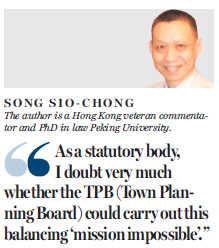Balancing planning restrictions and private property rights
Updated: 2016-10-05 07:20
By Song Sio-chong(HK Edition)
|
|||||||
On Sept 26, the Court of Final Appeal (CFA) ruled to remit to the Town Planning Board (TPB) as required by the Court of Appeal (CA) respecting planning restrictions on Hysan Development's 10 properties held under different company names - but not to refer to the reasons for reconsideration given in the CA judgment. That is to say, both courts agreed that the height and other restrictions of the TPB should be remitted, but not on the same legal basis.
Both courts were using so-called proportionality analysis in which three criteria are applied in Hong Kong. The first is whether the restrictions pursue a legitimate aim; the second is whether the measures are rationally connected to the overall purpose; and finally that they should be no more than necessary.
If I understand correctly, their differences are twofold. The first difference is that the CA rejected Hysan's argument to engage Article 6 and/or Article 105 of the Basic Law, but the CFA agreed to engage both articles in regard to protecting the rights of property developers. The second is whether the three criteria for "proportionality analysis" suffice; the CA agreed with them but the CFA argued with support from international cases that a reasonable balance should be struck between private property rights and planning restrictions for the benefit of the community.

Readers may find this concept too abstract; in which case let me explain, with the TPB's detailed restrictions in the said cases, as follows: (1) Building height restrictions to 130mPD (meters above the principal datum) in most cases; (2) Podium height restrictions to 32mPD and 20mPD at particular cases; (3) Non-building areas of 2m and 5m in the designated areas; and (4) Building setbacks of 1.5m and 0.5m in certain instances.
For these restrictions, the TPB may not find it difficult to satisfy the first two criteria of "proportionality analysis". The restrictions have a legitimate aim and the measures are rationally connected. As to the question of necessity, there would, however, be some controversy on whether building height restriction to 130mPD is necessary. Why not relax it to 150mPD or more? What should be a tolerable maximum? What would happen if Hysan did not accept it even if the restriction was relaxed? What would happen if other developers raised the same objection? It may be subject to further verification and interpretation.
Generally speaking, property developers want something more definite - so did the Hysan group. They claimed that such planning restrictions intruded on their property rights protected by Articles 6 and 105(1) of the Basic Law, and formulated their appeal based on this key issue.
Then the whole thing becomes a matter of legality, and not just rationality.
Article 6 of the Basic Law states that "The HKSAR shall protect the private ownership of property in accordance with law" and Article 105(1) stipulates that the SAR "shall in accordance with law, protect the right of individual and legal persons to the acquisition, use, disposal and inheritance of property and their rights to compensation for the lawful deprivation of their property".
In the eyes of the CFA, the TPB's restrictions would amount to deprivation. If such deprivation was exercised in accordance with law, it would still be considered as legal deprivation. But the TPB's planning restrictions contained in two drafted Outline Zoning Plans in 2010 respecting Hysan properties in Causeway Bay and Wan Chai - although exercised by the TPB in accordance with the Town Planning Ordinance - might not be a direct application or operation of that law for the TPB was still exercising discretion.
With Hysan's arguments in this respect having won the CFA's support, the TPB now faces two difficult tasks. One is to strike a proper balance between private property rights and planning restrictions. It would be an impossible mission to thoroughly satisfy property developers. Further negotiations might be required. As a statutory body, I doubt very much whether the TPB could carry out this balancing "mission impossible". If the TPB could accomplish this, it would have won the case in the CFA, not to mention the one in the lower court.
Another task is to have the Outline Zoning Plans legislated - and a brand new ordinance for Outline Zoning Plans might be needed here. Of the said restrictions, the most critical one is building and podium height restrictions. Based on an in-depth town planning study, the TPB should make contestable standards and criteria in determining the limitation of building heights and gaps, taking geographical, topographical, wind flow and ventilation, back-view and front-view of the sites, function of building population, transportation and other relevant factors into account. Then the legal drafter in the Department of Justice should try his best, based on the valid government policy, to formulate legal limitations and restrictions of town planning respecting various conditions in different districts, and have them legislated.
Let Outline Zoning Plans become one of the laws in the SAR as defined in Article 18(1) of the Basic Law, instead of mere decisions of a statutory body established by the Town Planning Ordinance. Then the TPB's decisions will satisfy the phrase "in accordance with law" in Article 6 and 105(1) of the Basic Law. Otherwise, more stringent challenges to the TPB's decisions will come in future due to the bitter prescription in the CFA's judgment.
(HK Edition 10/05/2016 page6)